SCU Online Advanced Intellectual Property Law Assignment - Semester 2
VerifiedAdded on 2022/08/26
|15
|3869
|23
Homework Assignment
AI Summary
This assignment delves into two key scenarios within intellectual property law. The first scenario examines the challenges to trademark registration, specifically focusing on the issues of deceptive similarity between product names and slogans, as well as the rights of non-registered trademarks. The analysis considers the Trade Marks Act 1995 (Cth) and the concept of passing off, exploring the potential outcomes for a product developer, Jack, facing objections from competitors Penny and Betty. The second scenario explores the use of the term 'Champagne' on a product label and the implications of geographical indications (GIs). It discusses the rights of the Champagne manufacturers in France to bring a claim against Jack, analyzing the role of certification trademarks, geographical indications, and international agreements like the Trade Marks Act 1995 (Cth) and the EU standards for protection. The assignment considers the Wine Australia Act 2013 and the case of Koppamurra Wines v Mildara Blass Ltd, concluding with the potential legal issues. It also provides an overview of international IP law, Australia's obligations under international treaties and agreements, and the role of organizations like the WTO.
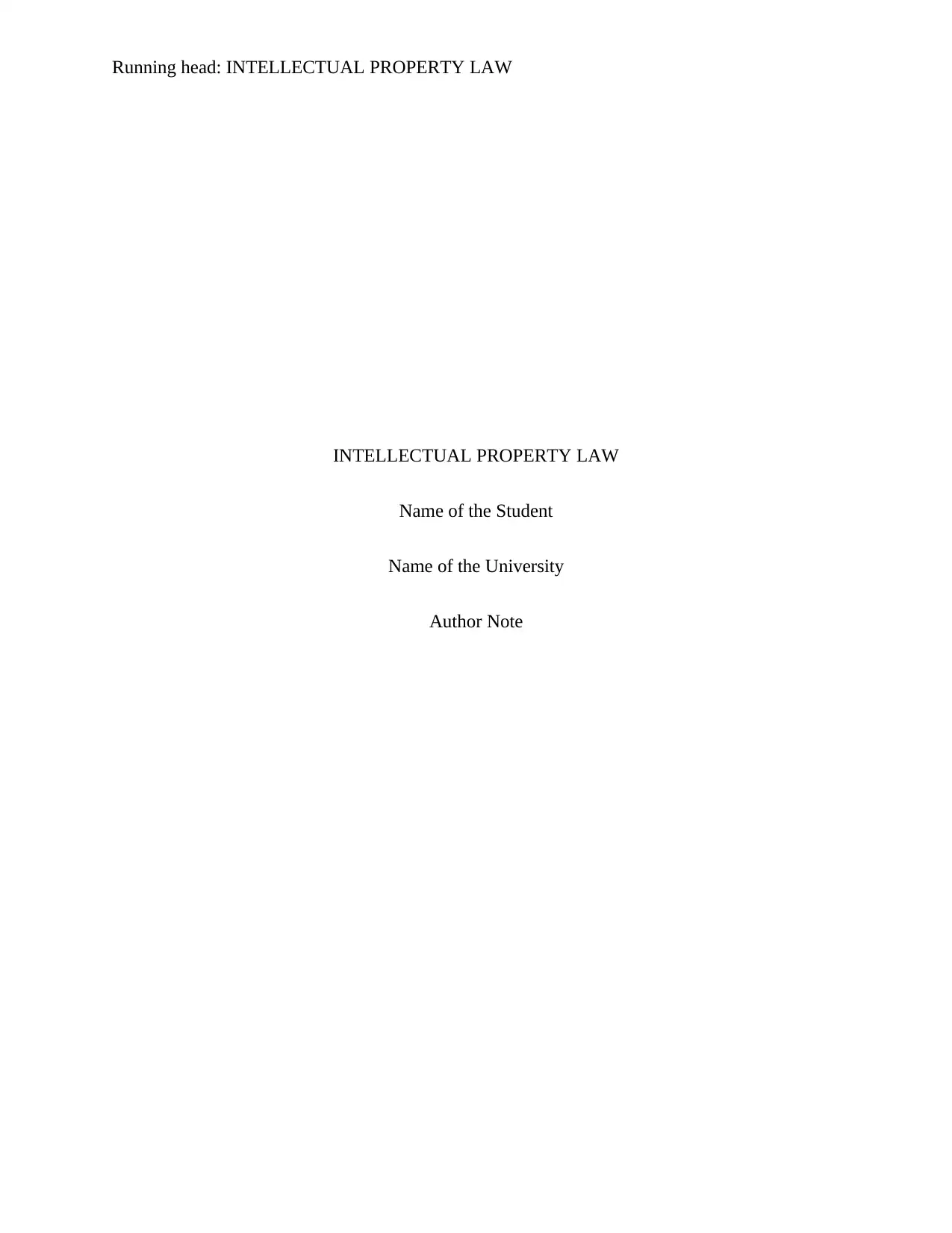
Running head: INTELLECTUAL PROPERTY LAW
INTELLECTUAL PROPERTY LAW
Name of the Student
Name of the University
Author Note
INTELLECTUAL PROPERTY LAW
Name of the Student
Name of the University
Author Note
Paraphrase This Document
Need a fresh take? Get an instant paraphrase of this document with our AI Paraphraser
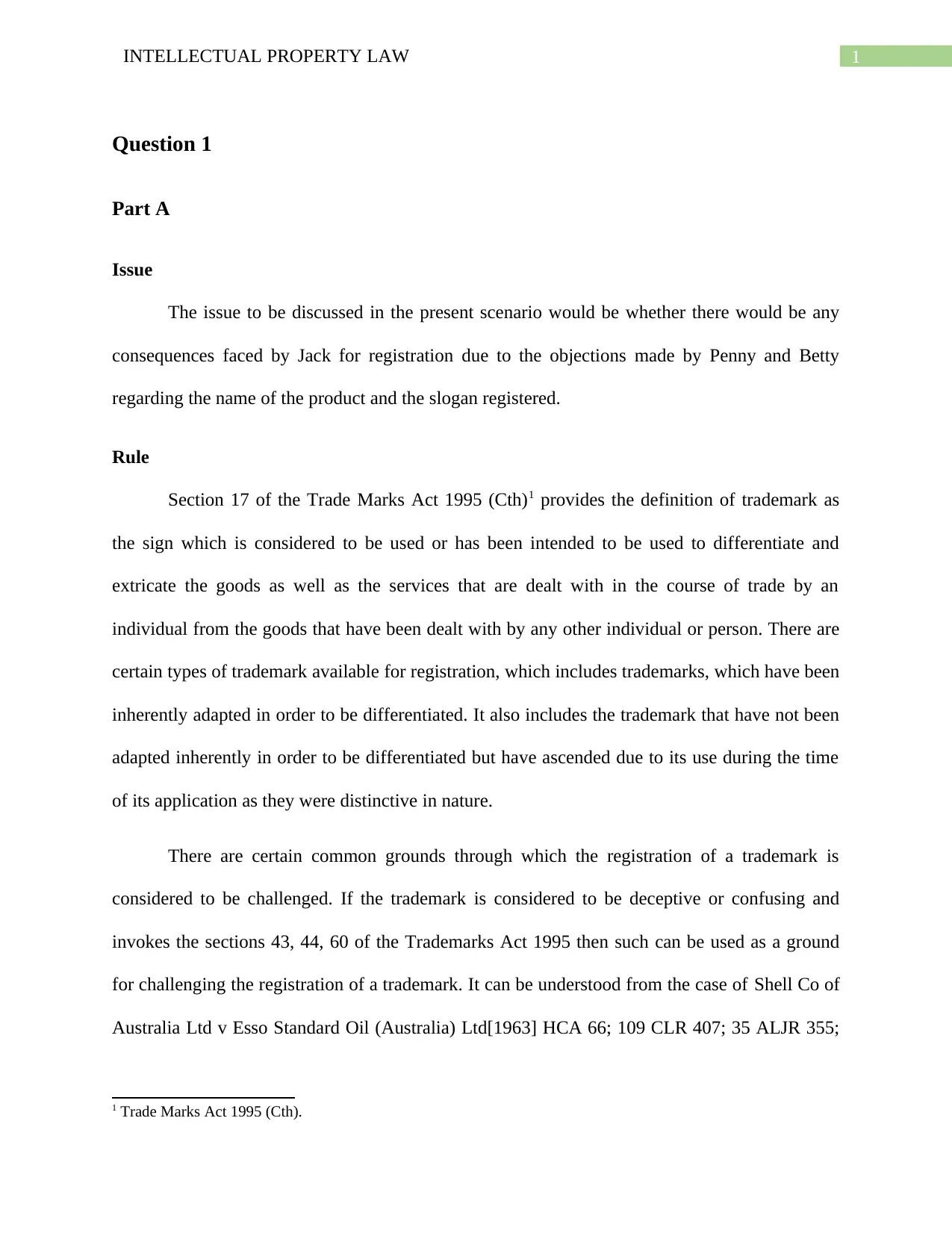
1INTELLECTUAL PROPERTY LAW
Question 1
Part A
Issue
The issue to be discussed in the present scenario would be whether there would be any
consequences faced by Jack for registration due to the objections made by Penny and Betty
regarding the name of the product and the slogan registered.
Rule
Section 17 of the Trade Marks Act 1995 (Cth)1 provides the definition of trademark as
the sign which is considered to be used or has been intended to be used to differentiate and
extricate the goods as well as the services that are dealt with in the course of trade by an
individual from the goods that have been dealt with by any other individual or person. There are
certain types of trademark available for registration, which includes trademarks, which have been
inherently adapted in order to be differentiated. It also includes the trademark that have not been
adapted inherently in order to be differentiated but have ascended due to its use during the time
of its application as they were distinctive in nature.
There are certain common grounds through which the registration of a trademark is
considered to be challenged. If the trademark is considered to be deceptive or confusing and
invokes the sections 43, 44, 60 of the Trademarks Act 1995 then such can be used as a ground
for challenging the registration of a trademark. It can be understood from the case of Shell Co of
Australia Ltd v Esso Standard Oil (Australia) Ltd[1963] HCA 66; 109 CLR 407; 35 ALJR 355;
1 Trade Marks Act 1995 (Cth).
Question 1
Part A
Issue
The issue to be discussed in the present scenario would be whether there would be any
consequences faced by Jack for registration due to the objections made by Penny and Betty
regarding the name of the product and the slogan registered.
Rule
Section 17 of the Trade Marks Act 1995 (Cth)1 provides the definition of trademark as
the sign which is considered to be used or has been intended to be used to differentiate and
extricate the goods as well as the services that are dealt with in the course of trade by an
individual from the goods that have been dealt with by any other individual or person. There are
certain types of trademark available for registration, which includes trademarks, which have been
inherently adapted in order to be differentiated. It also includes the trademark that have not been
adapted inherently in order to be differentiated but have ascended due to its use during the time
of its application as they were distinctive in nature.
There are certain common grounds through which the registration of a trademark is
considered to be challenged. If the trademark is considered to be deceptive or confusing and
invokes the sections 43, 44, 60 of the Trademarks Act 1995 then such can be used as a ground
for challenging the registration of a trademark. It can be understood from the case of Shell Co of
Australia Ltd v Esso Standard Oil (Australia) Ltd[1963] HCA 66; 109 CLR 407; 35 ALJR 355;
1 Trade Marks Act 1995 (Cth).
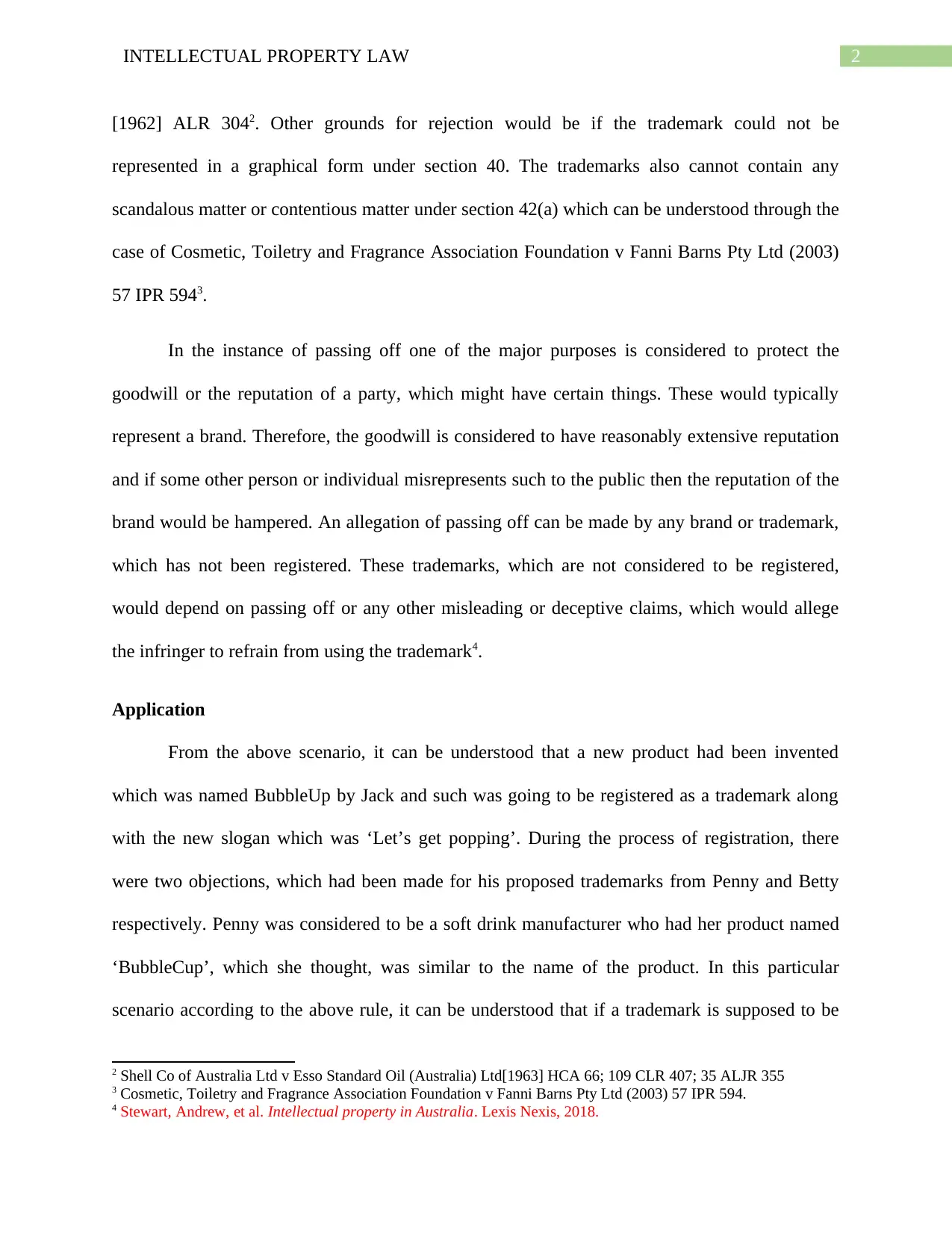
2INTELLECTUAL PROPERTY LAW
[1962] ALR 3042. Other grounds for rejection would be if the trademark could not be
represented in a graphical form under section 40. The trademarks also cannot contain any
scandalous matter or contentious matter under section 42(a) which can be understood through the
case of Cosmetic, Toiletry and Fragrance Association Foundation v Fanni Barns Pty Ltd (2003)
57 IPR 5943.
In the instance of passing off one of the major purposes is considered to protect the
goodwill or the reputation of a party, which might have certain things. These would typically
represent a brand. Therefore, the goodwill is considered to have reasonably extensive reputation
and if some other person or individual misrepresents such to the public then the reputation of the
brand would be hampered. An allegation of passing off can be made by any brand or trademark,
which has not been registered. These trademarks, which are not considered to be registered,
would depend on passing off or any other misleading or deceptive claims, which would allege
the infringer to refrain from using the trademark4.
Application
From the above scenario, it can be understood that a new product had been invented
which was named BubbleUp by Jack and such was going to be registered as a trademark along
with the new slogan which was ‘Let’s get popping’. During the process of registration, there
were two objections, which had been made for his proposed trademarks from Penny and Betty
respectively. Penny was considered to be a soft drink manufacturer who had her product named
‘BubbleCup’, which she thought, was similar to the name of the product. In this particular
scenario according to the above rule, it can be understood that if a trademark is supposed to be
2 Shell Co of Australia Ltd v Esso Standard Oil (Australia) Ltd[1963] HCA 66; 109 CLR 407; 35 ALJR 355
3 Cosmetic, Toiletry and Fragrance Association Foundation v Fanni Barns Pty Ltd (2003) 57 IPR 594.
4 Stewart, Andrew, et al. Intellectual property in Australia. Lexis Nexis, 2018.
[1962] ALR 3042. Other grounds for rejection would be if the trademark could not be
represented in a graphical form under section 40. The trademarks also cannot contain any
scandalous matter or contentious matter under section 42(a) which can be understood through the
case of Cosmetic, Toiletry and Fragrance Association Foundation v Fanni Barns Pty Ltd (2003)
57 IPR 5943.
In the instance of passing off one of the major purposes is considered to protect the
goodwill or the reputation of a party, which might have certain things. These would typically
represent a brand. Therefore, the goodwill is considered to have reasonably extensive reputation
and if some other person or individual misrepresents such to the public then the reputation of the
brand would be hampered. An allegation of passing off can be made by any brand or trademark,
which has not been registered. These trademarks, which are not considered to be registered,
would depend on passing off or any other misleading or deceptive claims, which would allege
the infringer to refrain from using the trademark4.
Application
From the above scenario, it can be understood that a new product had been invented
which was named BubbleUp by Jack and such was going to be registered as a trademark along
with the new slogan which was ‘Let’s get popping’. During the process of registration, there
were two objections, which had been made for his proposed trademarks from Penny and Betty
respectively. Penny was considered to be a soft drink manufacturer who had her product named
‘BubbleCup’, which she thought, was similar to the name of the product. In this particular
scenario according to the above rule, it can be understood that if a trademark is supposed to be
2 Shell Co of Australia Ltd v Esso Standard Oil (Australia) Ltd[1963] HCA 66; 109 CLR 407; 35 ALJR 355
3 Cosmetic, Toiletry and Fragrance Association Foundation v Fanni Barns Pty Ltd (2003) 57 IPR 594.
4 Stewart, Andrew, et al. Intellectual property in Australia. Lexis Nexis, 2018.
⊘ This is a preview!⊘
Do you want full access?
Subscribe today to unlock all pages.

Trusted by 1+ million students worldwide
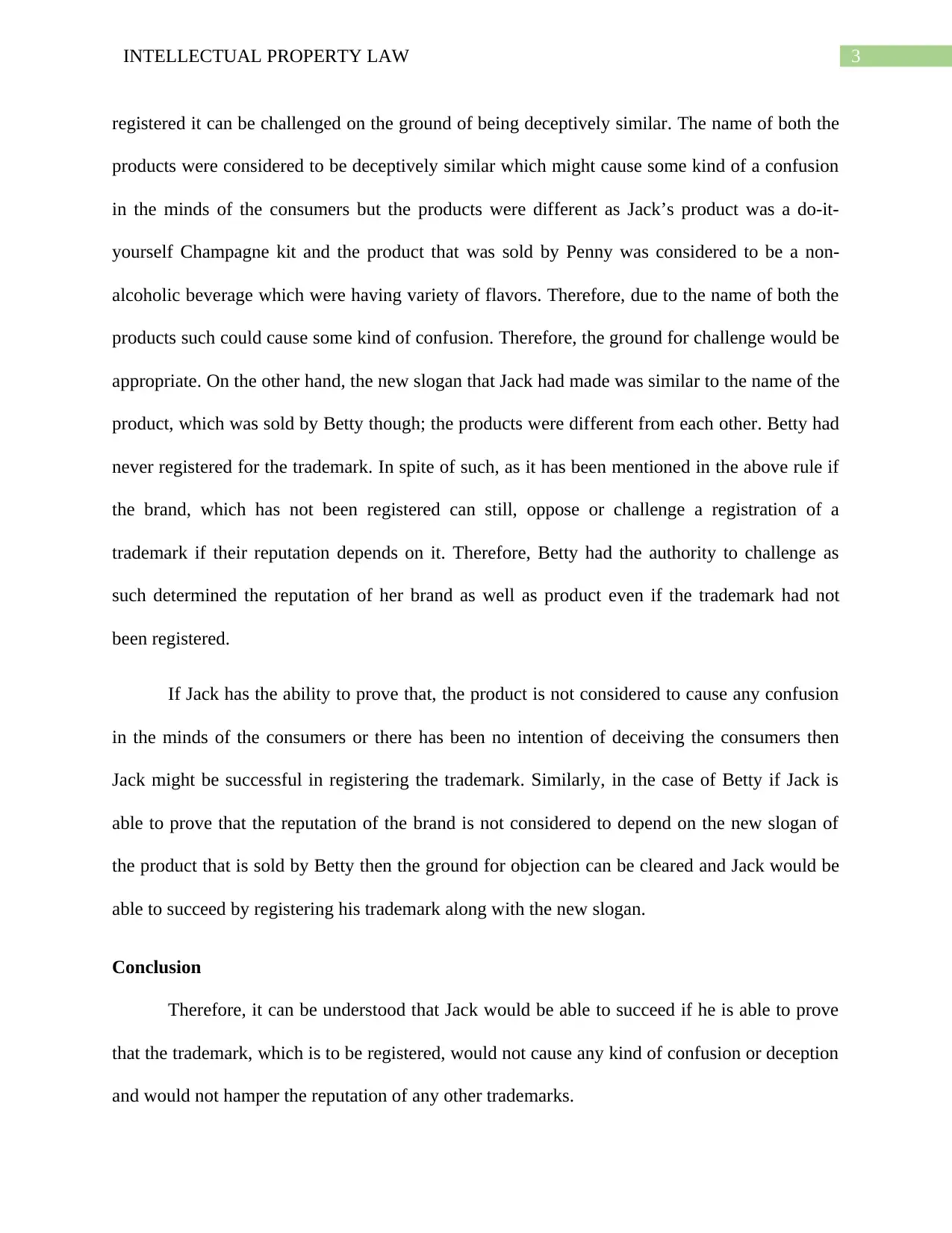
3INTELLECTUAL PROPERTY LAW
registered it can be challenged on the ground of being deceptively similar. The name of both the
products were considered to be deceptively similar which might cause some kind of a confusion
in the minds of the consumers but the products were different as Jack’s product was a do-it-
yourself Champagne kit and the product that was sold by Penny was considered to be a non-
alcoholic beverage which were having variety of flavors. Therefore, due to the name of both the
products such could cause some kind of confusion. Therefore, the ground for challenge would be
appropriate. On the other hand, the new slogan that Jack had made was similar to the name of the
product, which was sold by Betty though; the products were different from each other. Betty had
never registered for the trademark. In spite of such, as it has been mentioned in the above rule if
the brand, which has not been registered can still, oppose or challenge a registration of a
trademark if their reputation depends on it. Therefore, Betty had the authority to challenge as
such determined the reputation of her brand as well as product even if the trademark had not
been registered.
If Jack has the ability to prove that, the product is not considered to cause any confusion
in the minds of the consumers or there has been no intention of deceiving the consumers then
Jack might be successful in registering the trademark. Similarly, in the case of Betty if Jack is
able to prove that the reputation of the brand is not considered to depend on the new slogan of
the product that is sold by Betty then the ground for objection can be cleared and Jack would be
able to succeed by registering his trademark along with the new slogan.
Conclusion
Therefore, it can be understood that Jack would be able to succeed if he is able to prove
that the trademark, which is to be registered, would not cause any kind of confusion or deception
and would not hamper the reputation of any other trademarks.
registered it can be challenged on the ground of being deceptively similar. The name of both the
products were considered to be deceptively similar which might cause some kind of a confusion
in the minds of the consumers but the products were different as Jack’s product was a do-it-
yourself Champagne kit and the product that was sold by Penny was considered to be a non-
alcoholic beverage which were having variety of flavors. Therefore, due to the name of both the
products such could cause some kind of confusion. Therefore, the ground for challenge would be
appropriate. On the other hand, the new slogan that Jack had made was similar to the name of the
product, which was sold by Betty though; the products were different from each other. Betty had
never registered for the trademark. In spite of such, as it has been mentioned in the above rule if
the brand, which has not been registered can still, oppose or challenge a registration of a
trademark if their reputation depends on it. Therefore, Betty had the authority to challenge as
such determined the reputation of her brand as well as product even if the trademark had not
been registered.
If Jack has the ability to prove that, the product is not considered to cause any confusion
in the minds of the consumers or there has been no intention of deceiving the consumers then
Jack might be successful in registering the trademark. Similarly, in the case of Betty if Jack is
able to prove that the reputation of the brand is not considered to depend on the new slogan of
the product that is sold by Betty then the ground for objection can be cleared and Jack would be
able to succeed by registering his trademark along with the new slogan.
Conclusion
Therefore, it can be understood that Jack would be able to succeed if he is able to prove
that the trademark, which is to be registered, would not cause any kind of confusion or deception
and would not hamper the reputation of any other trademarks.
Paraphrase This Document
Need a fresh take? Get an instant paraphrase of this document with our AI Paraphraser
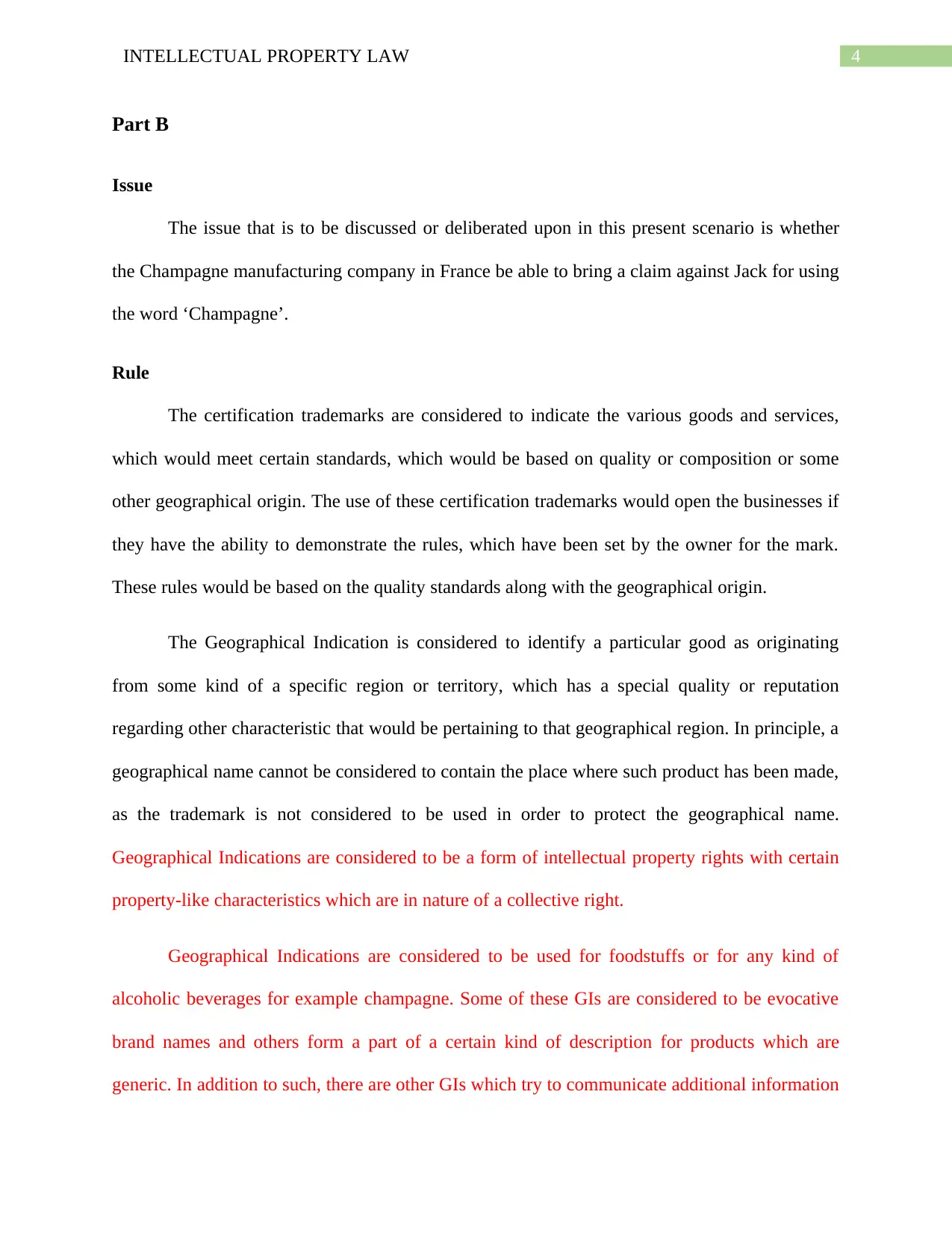
4INTELLECTUAL PROPERTY LAW
Part B
Issue
The issue that is to be discussed or deliberated upon in this present scenario is whether
the Champagne manufacturing company in France be able to bring a claim against Jack for using
the word ‘Champagne’.
Rule
The certification trademarks are considered to indicate the various goods and services,
which would meet certain standards, which would be based on quality or composition or some
other geographical origin. The use of these certification trademarks would open the businesses if
they have the ability to demonstrate the rules, which have been set by the owner for the mark.
These rules would be based on the quality standards along with the geographical origin.
The Geographical Indication is considered to identify a particular good as originating
from some kind of a specific region or territory, which has a special quality or reputation
regarding other characteristic that would be pertaining to that geographical region. In principle, a
geographical name cannot be considered to contain the place where such product has been made,
as the trademark is not considered to be used in order to protect the geographical name.
Geographical Indications are considered to be a form of intellectual property rights with certain
property-like characteristics which are in nature of a collective right.
Geographical Indications are considered to be used for foodstuffs or for any kind of
alcoholic beverages for example champagne. Some of these GIs are considered to be evocative
brand names and others form a part of a certain kind of description for products which are
generic. In addition to such, there are other GIs which try to communicate additional information
Part B
Issue
The issue that is to be discussed or deliberated upon in this present scenario is whether
the Champagne manufacturing company in France be able to bring a claim against Jack for using
the word ‘Champagne’.
Rule
The certification trademarks are considered to indicate the various goods and services,
which would meet certain standards, which would be based on quality or composition or some
other geographical origin. The use of these certification trademarks would open the businesses if
they have the ability to demonstrate the rules, which have been set by the owner for the mark.
These rules would be based on the quality standards along with the geographical origin.
The Geographical Indication is considered to identify a particular good as originating
from some kind of a specific region or territory, which has a special quality or reputation
regarding other characteristic that would be pertaining to that geographical region. In principle, a
geographical name cannot be considered to contain the place where such product has been made,
as the trademark is not considered to be used in order to protect the geographical name.
Geographical Indications are considered to be a form of intellectual property rights with certain
property-like characteristics which are in nature of a collective right.
Geographical Indications are considered to be used for foodstuffs or for any kind of
alcoholic beverages for example champagne. Some of these GIs are considered to be evocative
brand names and others form a part of a certain kind of description for products which are
generic. In addition to such, there are other GIs which try to communicate additional information
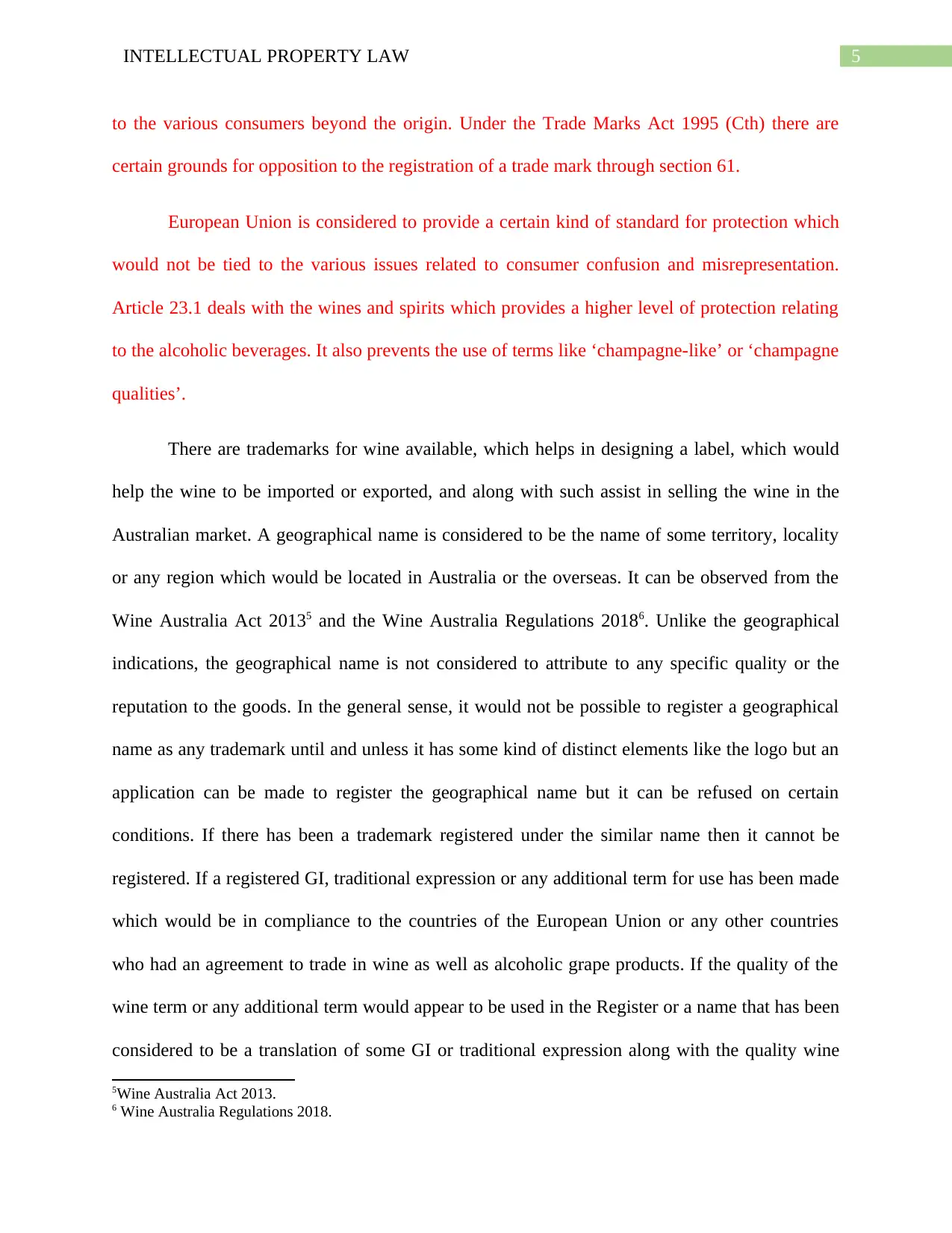
5INTELLECTUAL PROPERTY LAW
to the various consumers beyond the origin. Under the Trade Marks Act 1995 (Cth) there are
certain grounds for opposition to the registration of a trade mark through section 61.
European Union is considered to provide a certain kind of standard for protection which
would not be tied to the various issues related to consumer confusion and misrepresentation.
Article 23.1 deals with the wines and spirits which provides a higher level of protection relating
to the alcoholic beverages. It also prevents the use of terms like ‘champagne-like’ or ‘champagne
qualities’.
There are trademarks for wine available, which helps in designing a label, which would
help the wine to be imported or exported, and along with such assist in selling the wine in the
Australian market. A geographical name is considered to be the name of some territory, locality
or any region which would be located in Australia or the overseas. It can be observed from the
Wine Australia Act 20135 and the Wine Australia Regulations 20186. Unlike the geographical
indications, the geographical name is not considered to attribute to any specific quality or the
reputation to the goods. In the general sense, it would not be possible to register a geographical
name as any trademark until and unless it has some kind of distinct elements like the logo but an
application can be made to register the geographical name but it can be refused on certain
conditions. If there has been a trademark registered under the similar name then it cannot be
registered. If a registered GI, traditional expression or any additional term for use has been made
which would be in compliance to the countries of the European Union or any other countries
who had an agreement to trade in wine as well as alcoholic grape products. If the quality of the
wine term or any additional term would appear to be used in the Register or a name that has been
considered to be a translation of some GI or traditional expression along with the quality wine
5Wine Australia Act 2013.
6 Wine Australia Regulations 2018.
to the various consumers beyond the origin. Under the Trade Marks Act 1995 (Cth) there are
certain grounds for opposition to the registration of a trade mark through section 61.
European Union is considered to provide a certain kind of standard for protection which
would not be tied to the various issues related to consumer confusion and misrepresentation.
Article 23.1 deals with the wines and spirits which provides a higher level of protection relating
to the alcoholic beverages. It also prevents the use of terms like ‘champagne-like’ or ‘champagne
qualities’.
There are trademarks for wine available, which helps in designing a label, which would
help the wine to be imported or exported, and along with such assist in selling the wine in the
Australian market. A geographical name is considered to be the name of some territory, locality
or any region which would be located in Australia or the overseas. It can be observed from the
Wine Australia Act 20135 and the Wine Australia Regulations 20186. Unlike the geographical
indications, the geographical name is not considered to attribute to any specific quality or the
reputation to the goods. In the general sense, it would not be possible to register a geographical
name as any trademark until and unless it has some kind of distinct elements like the logo but an
application can be made to register the geographical name but it can be refused on certain
conditions. If there has been a trademark registered under the similar name then it cannot be
registered. If a registered GI, traditional expression or any additional term for use has been made
which would be in compliance to the countries of the European Union or any other countries
who had an agreement to trade in wine as well as alcoholic grape products. If the quality of the
wine term or any additional term would appear to be used in the Register or a name that has been
considered to be a translation of some GI or traditional expression along with the quality wine
5Wine Australia Act 2013.
6 Wine Australia Regulations 2018.
⊘ This is a preview!⊘
Do you want full access?
Subscribe today to unlock all pages.

Trusted by 1+ million students worldwide

6INTELLECTUAL PROPERTY LAW
term or any additional term that would be appearing in the Register. Any word or expression that
would resemble any GI or the traditional expression along with quality wine term. The address or
the name of a winery can be used as a representation for the application of trademark but such
should not be misused or used in a way that would mislead the location from which such wine
had been made and originated. As it can be understood from the case of Koppamurra Wines v
Mildara Blass Ltd [1998] 226 FCA [1998] FCA 226; 41 IPR 1547.
Application
In this present scenario, the first shipment of BubbleUp created by Jack was ready to be
shipped. Jack after two weeks of the shipment had been notified that the Champagne
manufacturers who were in France were intending on bringing a claim against Jack for using the
word ‘Champagne’ on the label. As it has been mentioned in the above rule that the GI mostly
focuses on or are used in foodstuffs or alcoholic beverages which also includes champagnes. The
GIs can be an evocative brand name or it can have certain characteristics of the product. In
addition to such it was also claimed by the Champagne manufacturers that the kit contained
some kind of reconstituted grape powder from the Australian grapes and not from the grapes of
the Champagne region. According to the above rule, it can be comprehended that a trademark
can be registered with a name of any place or territory as its label as the geographical name is not
considered to constitute any specific quality or reputation as long as it is in compliance with
certain conditions. It has additionally been stated that the GI cannot be misused in a manner
where the location or the place of the wine from where it had been originated be misled. As it has
been established in the case of Koppamurra Wines v Mildara Blass Ltd8. In this present scenario,
Jack had used the word Champagne on the label, which was considered to be a geographical
7 Koppamurra Wines v Mildara Blass Ltd [1998] 226 FCA [1998] FCA 226; 41 IPR 154.
8 Koppamurra Wines v Mildara Blass Ltd [1998] 226 FCA [1998] FCA 226; 41 IPR 154.
term or any additional term that would be appearing in the Register. Any word or expression that
would resemble any GI or the traditional expression along with quality wine term. The address or
the name of a winery can be used as a representation for the application of trademark but such
should not be misused or used in a way that would mislead the location from which such wine
had been made and originated. As it can be understood from the case of Koppamurra Wines v
Mildara Blass Ltd [1998] 226 FCA [1998] FCA 226; 41 IPR 1547.
Application
In this present scenario, the first shipment of BubbleUp created by Jack was ready to be
shipped. Jack after two weeks of the shipment had been notified that the Champagne
manufacturers who were in France were intending on bringing a claim against Jack for using the
word ‘Champagne’ on the label. As it has been mentioned in the above rule that the GI mostly
focuses on or are used in foodstuffs or alcoholic beverages which also includes champagnes. The
GIs can be an evocative brand name or it can have certain characteristics of the product. In
addition to such it was also claimed by the Champagne manufacturers that the kit contained
some kind of reconstituted grape powder from the Australian grapes and not from the grapes of
the Champagne region. According to the above rule, it can be comprehended that a trademark
can be registered with a name of any place or territory as its label as the geographical name is not
considered to constitute any specific quality or reputation as long as it is in compliance with
certain conditions. It has additionally been stated that the GI cannot be misused in a manner
where the location or the place of the wine from where it had been originated be misled. As it has
been established in the case of Koppamurra Wines v Mildara Blass Ltd8. In this present scenario,
Jack had used the word Champagne on the label, which was considered to be a geographical
7 Koppamurra Wines v Mildara Blass Ltd [1998] 226 FCA [1998] FCA 226; 41 IPR 154.
8 Koppamurra Wines v Mildara Blass Ltd [1998] 226 FCA [1998] FCA 226; 41 IPR 154.
Paraphrase This Document
Need a fresh take? Get an instant paraphrase of this document with our AI Paraphraser
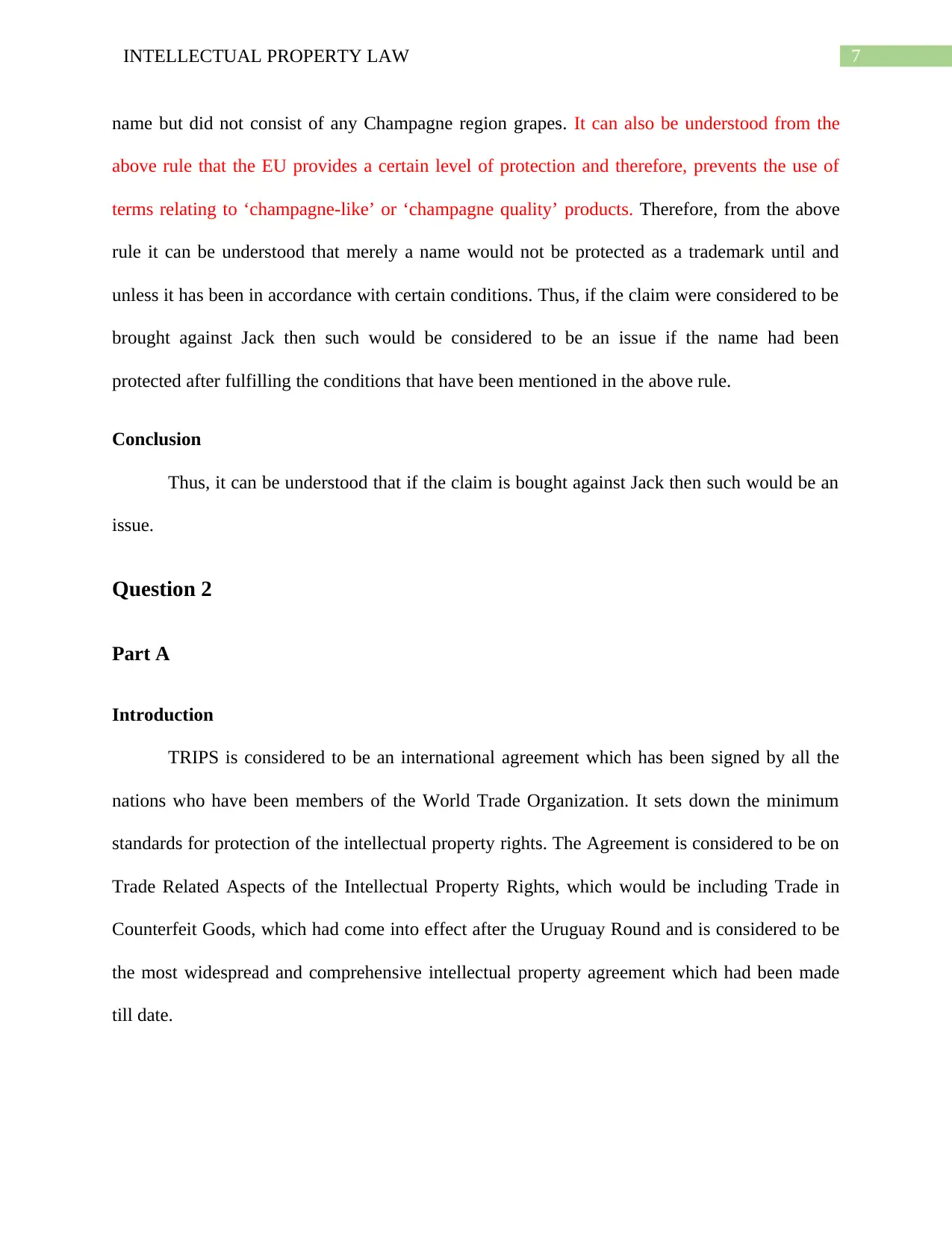
7INTELLECTUAL PROPERTY LAW
name but did not consist of any Champagne region grapes. It can also be understood from the
above rule that the EU provides a certain level of protection and therefore, prevents the use of
terms relating to ‘champagne-like’ or ‘champagne quality’ products. Therefore, from the above
rule it can be understood that merely a name would not be protected as a trademark until and
unless it has been in accordance with certain conditions. Thus, if the claim were considered to be
brought against Jack then such would be considered to be an issue if the name had been
protected after fulfilling the conditions that have been mentioned in the above rule.
Conclusion
Thus, it can be understood that if the claim is bought against Jack then such would be an
issue.
Question 2
Part A
Introduction
TRIPS is considered to be an international agreement which has been signed by all the
nations who have been members of the World Trade Organization. It sets down the minimum
standards for protection of the intellectual property rights. The Agreement is considered to be on
Trade Related Aspects of the Intellectual Property Rights, which would be including Trade in
Counterfeit Goods, which had come into effect after the Uruguay Round and is considered to be
the most widespread and comprehensive intellectual property agreement which had been made
till date.
name but did not consist of any Champagne region grapes. It can also be understood from the
above rule that the EU provides a certain level of protection and therefore, prevents the use of
terms relating to ‘champagne-like’ or ‘champagne quality’ products. Therefore, from the above
rule it can be understood that merely a name would not be protected as a trademark until and
unless it has been in accordance with certain conditions. Thus, if the claim were considered to be
brought against Jack then such would be considered to be an issue if the name had been
protected after fulfilling the conditions that have been mentioned in the above rule.
Conclusion
Thus, it can be understood that if the claim is bought against Jack then such would be an
issue.
Question 2
Part A
Introduction
TRIPS is considered to be an international agreement which has been signed by all the
nations who have been members of the World Trade Organization. It sets down the minimum
standards for protection of the intellectual property rights. The Agreement is considered to be on
Trade Related Aspects of the Intellectual Property Rights, which would be including Trade in
Counterfeit Goods, which had come into effect after the Uruguay Round and is considered to be
the most widespread and comprehensive intellectual property agreement which had been made
till date.
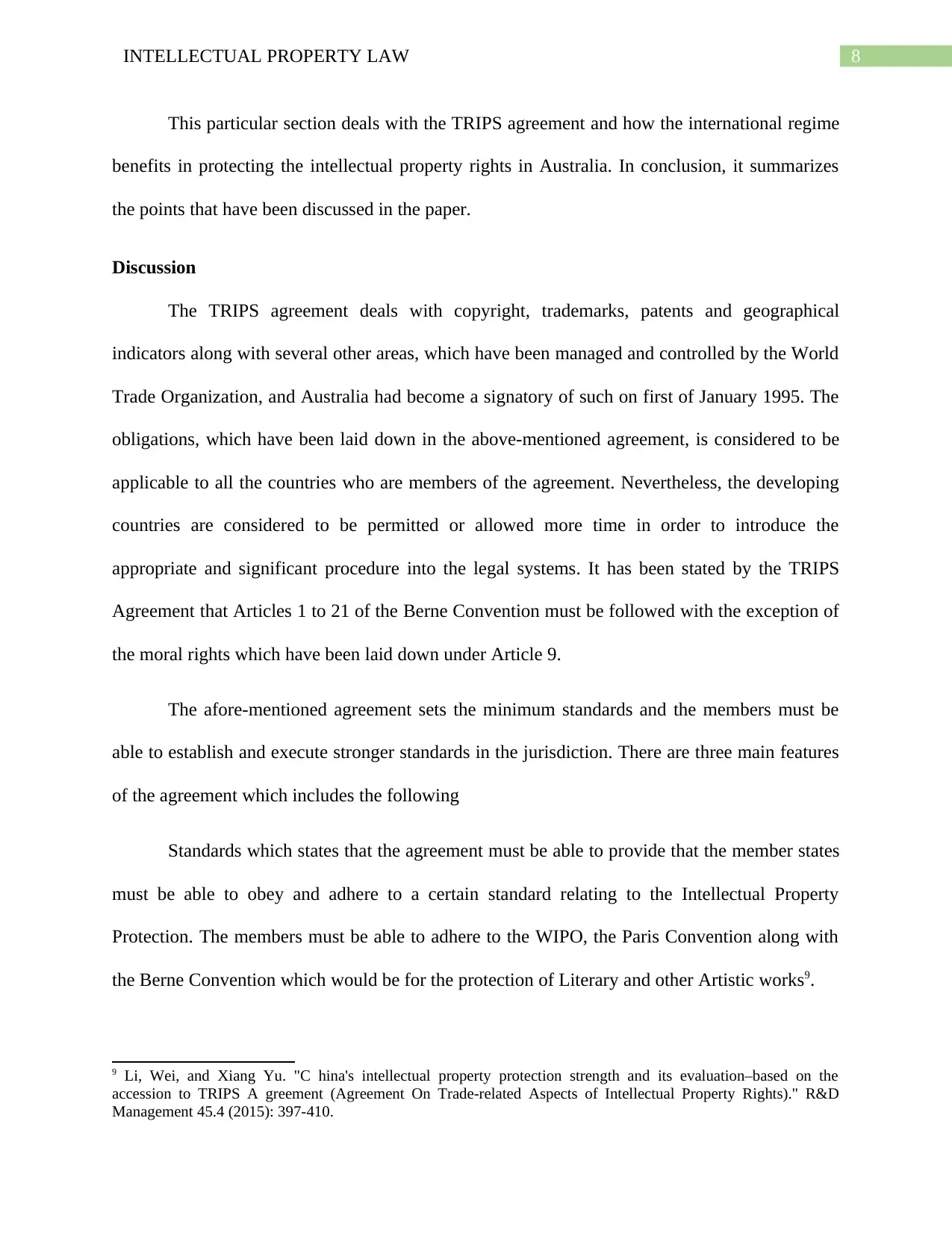
8INTELLECTUAL PROPERTY LAW
This particular section deals with the TRIPS agreement and how the international regime
benefits in protecting the intellectual property rights in Australia. In conclusion, it summarizes
the points that have been discussed in the paper.
Discussion
The TRIPS agreement deals with copyright, trademarks, patents and geographical
indicators along with several other areas, which have been managed and controlled by the World
Trade Organization, and Australia had become a signatory of such on first of January 1995. The
obligations, which have been laid down in the above-mentioned agreement, is considered to be
applicable to all the countries who are members of the agreement. Nevertheless, the developing
countries are considered to be permitted or allowed more time in order to introduce the
appropriate and significant procedure into the legal systems. It has been stated by the TRIPS
Agreement that Articles 1 to 21 of the Berne Convention must be followed with the exception of
the moral rights which have been laid down under Article 9.
The afore-mentioned agreement sets the minimum standards and the members must be
able to establish and execute stronger standards in the jurisdiction. There are three main features
of the agreement which includes the following
Standards which states that the agreement must be able to provide that the member states
must be able to obey and adhere to a certain standard relating to the Intellectual Property
Protection. The members must be able to adhere to the WIPO, the Paris Convention along with
the Berne Convention which would be for the protection of Literary and other Artistic works9.
9 Li, Wei, and Xiang Yu. "C hina's intellectual property protection strength and its evaluation–based on the
accession to TRIPS A greement (Agreement On Trade‐related Aspects of Intellectual Property Rights)." R&D
Management 45.4 (2015): 397-410.
This particular section deals with the TRIPS agreement and how the international regime
benefits in protecting the intellectual property rights in Australia. In conclusion, it summarizes
the points that have been discussed in the paper.
Discussion
The TRIPS agreement deals with copyright, trademarks, patents and geographical
indicators along with several other areas, which have been managed and controlled by the World
Trade Organization, and Australia had become a signatory of such on first of January 1995. The
obligations, which have been laid down in the above-mentioned agreement, is considered to be
applicable to all the countries who are members of the agreement. Nevertheless, the developing
countries are considered to be permitted or allowed more time in order to introduce the
appropriate and significant procedure into the legal systems. It has been stated by the TRIPS
Agreement that Articles 1 to 21 of the Berne Convention must be followed with the exception of
the moral rights which have been laid down under Article 9.
The afore-mentioned agreement sets the minimum standards and the members must be
able to establish and execute stronger standards in the jurisdiction. There are three main features
of the agreement which includes the following
Standards which states that the agreement must be able to provide that the member states
must be able to obey and adhere to a certain standard relating to the Intellectual Property
Protection. The members must be able to adhere to the WIPO, the Paris Convention along with
the Berne Convention which would be for the protection of Literary and other Artistic works9.
9 Li, Wei, and Xiang Yu. "C hina's intellectual property protection strength and its evaluation–based on the
accession to TRIPS A greement (Agreement On Trade‐related Aspects of Intellectual Property Rights)." R&D
Management 45.4 (2015): 397-410.
⊘ This is a preview!⊘
Do you want full access?
Subscribe today to unlock all pages.

Trusted by 1+ million students worldwide
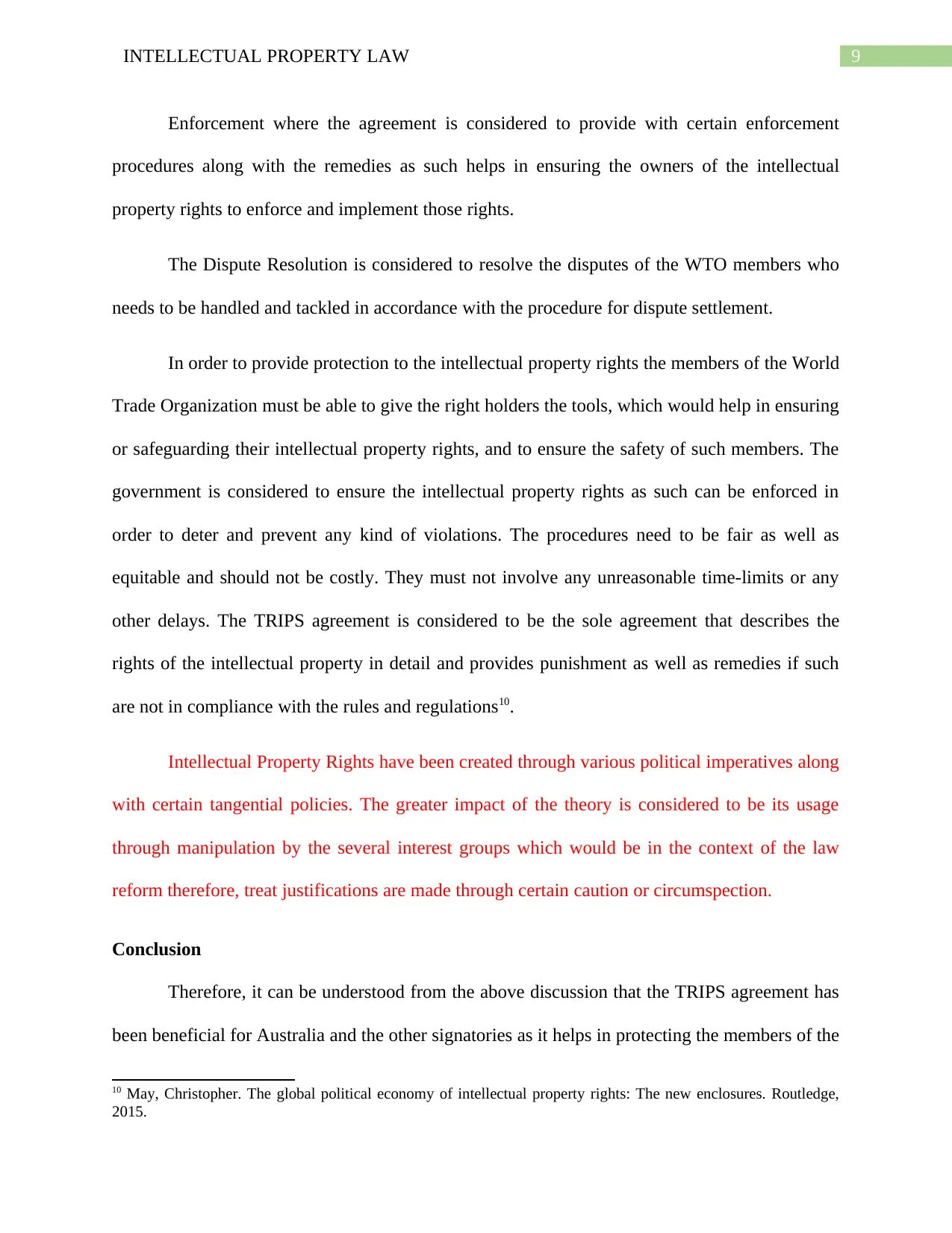
9INTELLECTUAL PROPERTY LAW
Enforcement where the agreement is considered to provide with certain enforcement
procedures along with the remedies as such helps in ensuring the owners of the intellectual
property rights to enforce and implement those rights.
The Dispute Resolution is considered to resolve the disputes of the WTO members who
needs to be handled and tackled in accordance with the procedure for dispute settlement.
In order to provide protection to the intellectual property rights the members of the World
Trade Organization must be able to give the right holders the tools, which would help in ensuring
or safeguarding their intellectual property rights, and to ensure the safety of such members. The
government is considered to ensure the intellectual property rights as such can be enforced in
order to deter and prevent any kind of violations. The procedures need to be fair as well as
equitable and should not be costly. They must not involve any unreasonable time-limits or any
other delays. The TRIPS agreement is considered to be the sole agreement that describes the
rights of the intellectual property in detail and provides punishment as well as remedies if such
are not in compliance with the rules and regulations10.
Intellectual Property Rights have been created through various political imperatives along
with certain tangential policies. The greater impact of the theory is considered to be its usage
through manipulation by the several interest groups which would be in the context of the law
reform therefore, treat justifications are made through certain caution or circumspection.
Conclusion
Therefore, it can be understood from the above discussion that the TRIPS agreement has
been beneficial for Australia and the other signatories as it helps in protecting the members of the
10 May, Christopher. The global political economy of intellectual property rights: The new enclosures. Routledge,
2015.
Enforcement where the agreement is considered to provide with certain enforcement
procedures along with the remedies as such helps in ensuring the owners of the intellectual
property rights to enforce and implement those rights.
The Dispute Resolution is considered to resolve the disputes of the WTO members who
needs to be handled and tackled in accordance with the procedure for dispute settlement.
In order to provide protection to the intellectual property rights the members of the World
Trade Organization must be able to give the right holders the tools, which would help in ensuring
or safeguarding their intellectual property rights, and to ensure the safety of such members. The
government is considered to ensure the intellectual property rights as such can be enforced in
order to deter and prevent any kind of violations. The procedures need to be fair as well as
equitable and should not be costly. They must not involve any unreasonable time-limits or any
other delays. The TRIPS agreement is considered to be the sole agreement that describes the
rights of the intellectual property in detail and provides punishment as well as remedies if such
are not in compliance with the rules and regulations10.
Intellectual Property Rights have been created through various political imperatives along
with certain tangential policies. The greater impact of the theory is considered to be its usage
through manipulation by the several interest groups which would be in the context of the law
reform therefore, treat justifications are made through certain caution or circumspection.
Conclusion
Therefore, it can be understood from the above discussion that the TRIPS agreement has
been beneficial for Australia and the other signatories as it helps in protecting the members of the
10 May, Christopher. The global political economy of intellectual property rights: The new enclosures. Routledge,
2015.
Paraphrase This Document
Need a fresh take? Get an instant paraphrase of this document with our AI Paraphraser

10INTELLECTUAL PROPERTY LAW
agreement from any violation or infringement against the intellectual property rights. The TRIPS
agreement helps in bringing the countries together as signatories and assists them in
incorporating the rights into their own domestic laws, which would help in creating a better
scope for these kind of rights. Therefore, the agreement is considered to be beneficial as it helps
in protecting the intellectual property rights from any kind of infringement.
Part B
Introduction
This section discusses the international regime that would help in regulating the
intellectual property rights effectively at the national level in all the countries. It further discusses
the difficulties in implementation of such in the developing countries in particular. Lastly, it
concludes by summarizing the points that have been discussed in the paper.
Discussion
There is a certain level of connection between the intellectual property and the economic
development, which varies over time from one nation or region to another region. It can be
understood that the intellectual property has played a pivotal role in the economic growth of the
United States as they have introduced pro-competitive patent laws although it had weak
copyright laws. In spite of such the economy had managed to thrive and survive within the
highly competitive environment. Similarly, on the other hand the developing countries were
considered to obtain relatively high levels of economic growth without any strong or robust
doctrine of intellectual property rights. Therefore, it can be comprehended that such a
phenomenon provides that the intellectual property rights can be considered as one of the
component which are responsible for the economic growth as separate states have separate factor
agreement from any violation or infringement against the intellectual property rights. The TRIPS
agreement helps in bringing the countries together as signatories and assists them in
incorporating the rights into their own domestic laws, which would help in creating a better
scope for these kind of rights. Therefore, the agreement is considered to be beneficial as it helps
in protecting the intellectual property rights from any kind of infringement.
Part B
Introduction
This section discusses the international regime that would help in regulating the
intellectual property rights effectively at the national level in all the countries. It further discusses
the difficulties in implementation of such in the developing countries in particular. Lastly, it
concludes by summarizing the points that have been discussed in the paper.
Discussion
There is a certain level of connection between the intellectual property and the economic
development, which varies over time from one nation or region to another region. It can be
understood that the intellectual property has played a pivotal role in the economic growth of the
United States as they have introduced pro-competitive patent laws although it had weak
copyright laws. In spite of such the economy had managed to thrive and survive within the
highly competitive environment. Similarly, on the other hand the developing countries were
considered to obtain relatively high levels of economic growth without any strong or robust
doctrine of intellectual property rights. Therefore, it can be comprehended that such a
phenomenon provides that the intellectual property rights can be considered as one of the
component which are responsible for the economic growth as separate states have separate factor
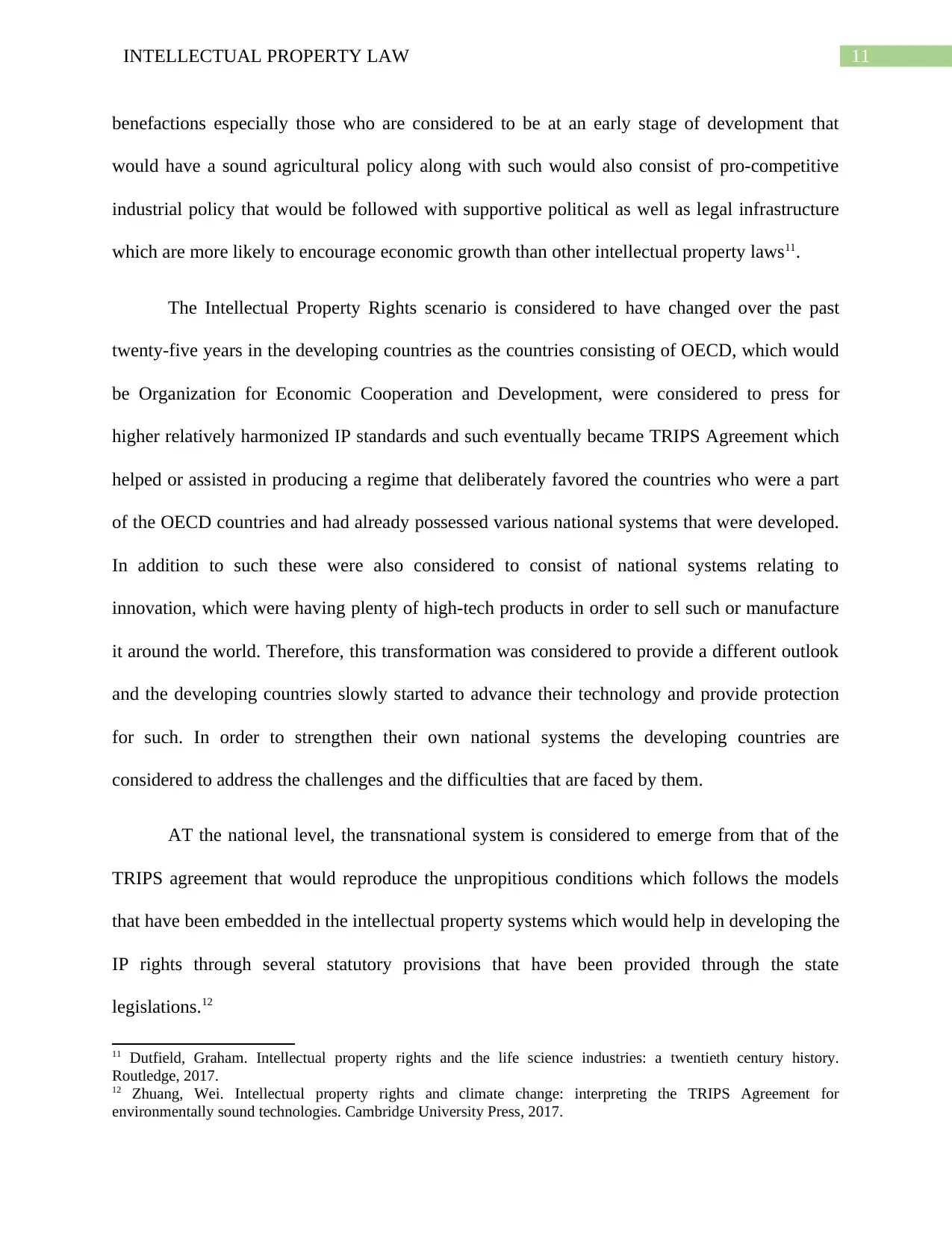
11INTELLECTUAL PROPERTY LAW
benefactions especially those who are considered to be at an early stage of development that
would have a sound agricultural policy along with such would also consist of pro-competitive
industrial policy that would be followed with supportive political as well as legal infrastructure
which are more likely to encourage economic growth than other intellectual property laws11.
The Intellectual Property Rights scenario is considered to have changed over the past
twenty-five years in the developing countries as the countries consisting of OECD, which would
be Organization for Economic Cooperation and Development, were considered to press for
higher relatively harmonized IP standards and such eventually became TRIPS Agreement which
helped or assisted in producing a regime that deliberately favored the countries who were a part
of the OECD countries and had already possessed various national systems that were developed.
In addition to such these were also considered to consist of national systems relating to
innovation, which were having plenty of high-tech products in order to sell such or manufacture
it around the world. Therefore, this transformation was considered to provide a different outlook
and the developing countries slowly started to advance their technology and provide protection
for such. In order to strengthen their own national systems the developing countries are
considered to address the challenges and the difficulties that are faced by them.
AT the national level, the transnational system is considered to emerge from that of the
TRIPS agreement that would reproduce the unpropitious conditions which follows the models
that have been embedded in the intellectual property systems which would help in developing the
IP rights through several statutory provisions that have been provided through the state
legislations.12
11 Dutfield, Graham. Intellectual property rights and the life science industries: a twentieth century history.
Routledge, 2017.
12 Zhuang, Wei. Intellectual property rights and climate change: interpreting the TRIPS Agreement for
environmentally sound technologies. Cambridge University Press, 2017.
benefactions especially those who are considered to be at an early stage of development that
would have a sound agricultural policy along with such would also consist of pro-competitive
industrial policy that would be followed with supportive political as well as legal infrastructure
which are more likely to encourage economic growth than other intellectual property laws11.
The Intellectual Property Rights scenario is considered to have changed over the past
twenty-five years in the developing countries as the countries consisting of OECD, which would
be Organization for Economic Cooperation and Development, were considered to press for
higher relatively harmonized IP standards and such eventually became TRIPS Agreement which
helped or assisted in producing a regime that deliberately favored the countries who were a part
of the OECD countries and had already possessed various national systems that were developed.
In addition to such these were also considered to consist of national systems relating to
innovation, which were having plenty of high-tech products in order to sell such or manufacture
it around the world. Therefore, this transformation was considered to provide a different outlook
and the developing countries slowly started to advance their technology and provide protection
for such. In order to strengthen their own national systems the developing countries are
considered to address the challenges and the difficulties that are faced by them.
AT the national level, the transnational system is considered to emerge from that of the
TRIPS agreement that would reproduce the unpropitious conditions which follows the models
that have been embedded in the intellectual property systems which would help in developing the
IP rights through several statutory provisions that have been provided through the state
legislations.12
11 Dutfield, Graham. Intellectual property rights and the life science industries: a twentieth century history.
Routledge, 2017.
12 Zhuang, Wei. Intellectual property rights and climate change: interpreting the TRIPS Agreement for
environmentally sound technologies. Cambridge University Press, 2017.
⊘ This is a preview!⊘
Do you want full access?
Subscribe today to unlock all pages.

Trusted by 1+ million students worldwide
1 out of 15
Related Documents
Your All-in-One AI-Powered Toolkit for Academic Success.
+13062052269
info@desklib.com
Available 24*7 on WhatsApp / Email
![[object Object]](/_next/static/media/star-bottom.7253800d.svg)
Unlock your academic potential
Copyright © 2020–2025 A2Z Services. All Rights Reserved. Developed and managed by ZUCOL.





